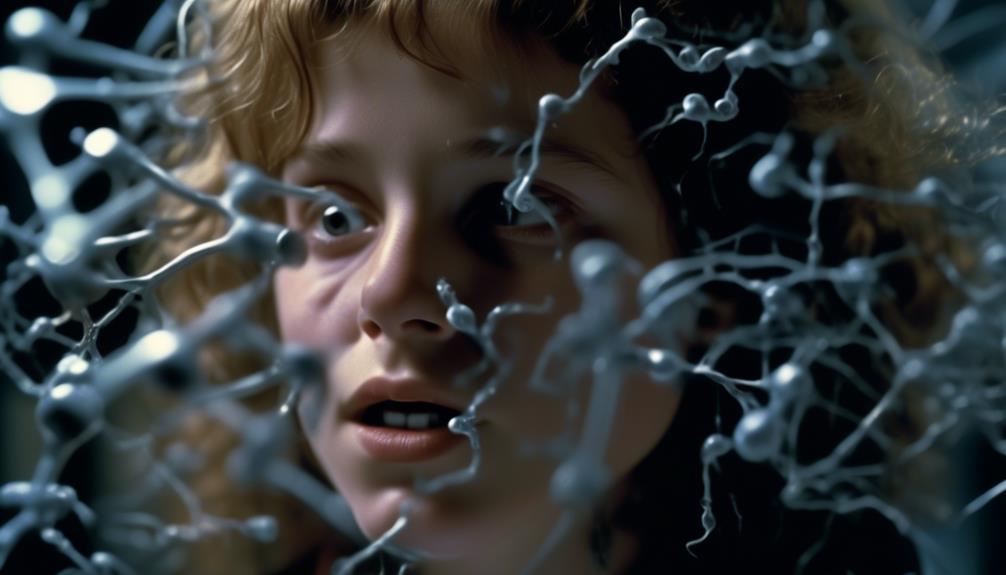Discovery of Prion Diseases in Humans (1996) – Prusiner: Recap and Summary: Found Prions Cause Diseases Like CJD

Prion diseases in humans are a group of rare and fatal neurodegenerative disorders. These disorders are caused by abnormal proteins called prions. The discovery that prions are the cause of these diseases was made by Stanley B. Prusiner in the 1980s. Prusiner's research revolutionized the understanding of neurodegenerative diseases and earned him the Nobel Prize in Physiology or Medicine in 1997.
Prion diseases, also known as transmissible spongiform encephalopathies (TSEs), affect the brain and nervous system. They are characterized by the accumulation of misfolded prion proteins, which leads to the formation of insoluble aggregates. These aggregates disrupt normal brain function and cause progressive degeneration of brain tissue.
The most well-known prion disease in humans is Creutzfeldt-Jakob disease (CJD). It is a rare and rapidly progressive disorder that affects about one in every one million people worldwide. CJD can be sporadic, inherited, or acquired through exposure to infected tissue, such as contaminated surgical instruments or corneal transplants.
Prusiner's discovery of prions as the cause of CJD and other prion diseases was groundbreaking. Prior to his research, these diseases were poorly understood and often misdiagnosed. Prusiner's work not only shed light on the underlying cause of these devastating disorders but also paved the way for better diagnostic methods and potential treatments.
Today, prion diseases remain a significant challenge in the field of neurology. Despite advances in research, there is still no cure for these diseases. However, ongoing studies continue to deepen our understanding of prions and provide hope for future therapeutic interventions.
Key Takeaways
- Prion diseases are rare and fatal neurodegenerative disorders caused by abnormal proteins called prions.
- Creutzfeldt-Jakob Disease (CJD) is the most well-known prion disease in humans, and it can be sporadic, inherited, or acquired through exposure to infected tissue.
- Prions are misfolded proteins that can induce normal proteins to adopt the abnormal conformation, leading to the accumulation of protein aggregates and the development of prion diseases.
- Prion diseases can be transmitted from animals to humans, primarily through the consumption of prion-infected animal products, such as cattle and deer. Close contact with infected animals or exposure to their bodily fluids also increases the risk of transmission.
The Prion Hypothesis: Challenging Traditional Disease Models
The prion hypothesis challenges traditional disease models by proposing a unique mechanism of transmission and pathology. Unlike other infectious agents, prions aren't composed of nucleic acids, but rather misfolded proteins that can induce normal proteins to adopt the abnormal conformation. This conformational change leads to the accumulation of protein aggregates, resulting in the development of neurodegenerative disorders known as prion diseases.
The implications for healthcare are profound. Prion diseases, such as Creutzfeldt-Jakob disease (CJD), are invariably fatal and currently have no effective treatments. The challenge lies in detecting prions early, as they can remain silent for years before symptoms manifest. Moreover, prions are highly resistant to standard decontamination procedures, making it crucial to implement stringent measures to prevent their transmission in hospitals and other healthcare settings.
Understanding the prion hypothesis has far-reaching implications beyond prion diseases themselves. It challenges the fundamental understanding of infectious agents and opens up new avenues for research in other neurodegenerative diseases, such as Alzheimer's and Parkinson's. By challenging traditional models, the prion hypothesis forces scientists and healthcare professionals to think outside the box and consider unconventional mechanisms of disease transmission and pathology. This shift in thinking may ultimately lead to breakthroughs in treatment and prevention strategies for a wide range of diseases.
Dr. Stanley Prusiner: Pioneering Prion Research
Now let's turn our attention to the groundbreaking work of Dr. Stanley Prusiner in the field of prion research.
His discovery of prions challenged traditional disease models and revolutionized our understanding of infectious diseases.
Prusiner's Groundbreaking Discovery
In his groundbreaking research on prions, Dr. Stanley Prusiner pioneered a new understanding of these elusive infectious agents. His work had a profound impact on the field of neurodegenerative diseases and unveiled the mysteries surrounding prions.
Prusiner discovered that prions are abnormal proteins that can cause serious disorders, such as Creutzfeldt-Jakob disease (CJD) and variant CJD. Contrary to traditional beliefs, he showed that prions aren't viruses or bacteria, but rather misfolded versions of a normal cellular protein. This groundbreaking discovery challenged the existing scientific paradigm and opened up new avenues of research into the mechanisms of prion diseases.
Prusiner's findings not only revolutionized our understanding of these diseases but also paved the way for innovative diagnostic methods and potential therapeutic interventions.
Uncovering Prion Disease Mechanisms
What are the mechanisms behind prion diseases?
Prion diseases are caused by the misfolding of normal proteins, known as prion proteins, into an abnormal shape. This misfolded protein can then convert other normal prion proteins into the abnormal form, leading to the accumulation of these abnormal proteins in the brain.
The exact mechanisms behind prion disease transmission and progression aren't fully understood, but it's believed that the misfolded prion proteins can spread from cell to cell, causing damage and ultimately leading to the development of symptoms.
Diagnosis of prion diseases can be challenging, as they share similar symptoms with other neurodegenerative disorders. It typically involves a combination of clinical evaluation, brain imaging, and laboratory tests to detect abnormal prion proteins in the cerebrospinal fluid or brain tissue.
Impact of Prusiner's Research
Prusiner's groundbreaking research on prion diseases revolutionized our understanding of these neurodegenerative disorders. His findings had a significant impact on the medical community and raised public awareness about these previously misunderstood diseases.
- Impact on the medical community:
- Prusiner's research led to the development of diagnostic tests for prion diseases, enabling early detection and intervention.
- His work also paved the way for the development of potential treatments for prion diseases, offering hope to patients and their families.
- Public awareness:
- Prusiner's research brought prion diseases into the spotlight, increasing public awareness about their existence and potential risks.
- This increased awareness led to improved safety measures in the handling of animal products, reducing the risk of prion transmission to humans.
Unraveling the Mystery of Misfolded Proteins
Understanding the mechanisms behind the misfolding of proteins is a crucial step in unraveling the mystery of prion diseases in humans. Protein folding is a complex process in which a linear chain of amino acids adopts a specific three-dimensional structure. This structure is essential for the protein to carry out its function effectively. However, sometimes proteins can misfold, leading to their abnormal conformation.
Misfolded proteins can have serious consequences for human health. They can aggregate and form clumps, disrupting cellular processes and causing cellular toxicity. In the case of prion diseases, misfolded prion proteins can induce other normally folded prion proteins to adopt the abnormal conformation, propagating the disease.
Researchers have made significant progress in understanding the disease mechanisms underlying protein misfolding. They've identified specific genetic mutations that can increase the likelihood of protein misfolding and have discovered the role of cellular quality control systems in recognizing and degrading misfolded proteins. Additionally, studies have shown that environmental factors, such as exposure to certain chemicals or stress, can also contribute to protein misfolding.
Linking Prions to Neurodegenerative Disorders
Scientists have successfully established a connection between prions and various neurodegenerative disorders. Prions, the misfolded proteins that cause diseases like Creutzfeldt-Jakob Disease (CJD), have been found to play a role in other neurodegenerative disorders such as Alzheimer's and Parkinson's.
- Prions and Alzheimer's: Research has shown that prion-like proteins, such as beta-amyloid and tau, can spread through the brain and contribute to the development and progression of Alzheimer's disease. These proteins can induce misfolding of normal proteins, leading to the formation of plaques and tangles, which are characteristic features of Alzheimer's.
- Prions and Parkinson's: Studies have also revealed a connection between prions and Parkinson's disease. It has been suggested that misfolded alpha-synuclein proteins, similar to prions, can propagate and aggregate in the brain, causing the degeneration of dopamine-producing neurons. This accumulation of toxic proteins ultimately leads to the motor and cognitive symptoms associated with Parkinson's.
Understanding the role of prions in neurodegenerative disorders is essential for developing effective treatments and preventive measures. Further research is needed to unravel the complex mechanisms underlying these diseases and to explore potential therapeutic targets.
Creutzfeldt-Jakob Disease (CJD): A Devastating Prion Disease
Creutzfeldt-Jakob Disease (CJD) is a devastating prion disease that affects the brain and nervous system. It is a rare, yet fatal neurodegenerative disorder that leads to severe cognitive decline, muscle stiffness, and coordination problems. The exact cause of CJD is still unknown, but it is believed to be caused by the accumulation of abnormal prion proteins in the brain.
CJD can be classified into three different forms: sporadic, genetic, and acquired. Sporadic CJD is the most common form and occurs spontaneously without any known cause. Genetic CJD is inherited and caused by mutations in the PRNP gene. Acquired CJD, on the other hand, can be transmitted through various routes, including contaminated medical equipment, organ transplants, and consumption of infected tissues.
To emphasize the devastating effects of CJD, let's take a look at the following table:
| Devastating Effects of CJD |
|---|
| Rapidly progressive dementia |
| Loss of motor control |
| Muscle stiffness |
| Difficulty speaking and swallowing |
| Severe cognitive decline |
As you can see, CJD has a profound impact on the affected individuals, leading to a rapid deterioration of their physical and mental abilities. It is important to understand the transmission routes of CJD in order to prevent its spread and protect public health.
Prion Transmission: From Animals to Humans
Prion transmission from animals to humans is a concerning aspect of prion diseases. Prions, the misfolded proteins responsible for these diseases, can be transmitted from infected animals to humans through various means. Here are the key points regarding animal to human transmission:
- Zoonotic Transmission:
- Prion diseases like variant Creutzfeldt-Jakob Disease (vCJD) are considered zoonotic, meaning they can be transmitted from animals to humans.
- The primary source of zoonotic transmission is through the consumption of prion-infected animal products, particularly those from cattle.
- The prions can be present in the brain, spinal cord, and other tissues of infected animals, and their consumption can lead to the development of prion diseases in humans.
- Animal Reservoirs:
- Certain animal species, such as cows (in the case of Bovine Spongiform Encephalopathy or BSE) and deer (in the case of Chronic Wasting Disease or CWD), are known to carry prions and serve as reservoirs for transmission to humans.
- Close contact with infected animals, exposure to their bodily fluids, or handling their tissues can increase the risk of transmission.
Understanding the animal to human transmission of prion diseases is crucial for public health measures and prevention strategies. Efforts to monitor and control prion infections in livestock and wildlife, as well as implementing safe food practices, are essential in minimizing the risk of zoonotic transmission.
Prion Disease Diagnosis and Treatment: Current Challenges
Diagnosing and treating prion diseases present significant challenges due to the complexity of their symptoms and the lack of effective therapeutic options. Prion diseases are difficult to diagnose accurately, as their symptoms can resemble those of other neurological disorders. Currently, the gold standard for diagnosis is a brain biopsy, which is an invasive and risky procedure. There is a need for more reliable and accessible diagnostic methods that can detect prions in body fluids or tissues.
Table: Challenges in Prion Detection
| Challenge | Description |
|---|---|
| Lack of specific biomarkers | Prion diseases lack specific biomarkers, making it difficult to differentiate them from other diseases. |
| Limited availability of diagnostic tests | Currently, there are limited diagnostic tests available for prion diseases, making early detection challenging. |
| Invasive diagnostic procedures | The current diagnostic procedures, such as brain biopsies, are invasive and carry risks for the patients. |
In terms of treatment, there are no approved therapies that can cure or slow down the progression of prion diseases. The underlying mechanisms of prion diseases are still not fully understood, which hinders the development of targeted therapies. However, researchers are exploring novel approaches, including immunotherapies and gene therapies, to halt the accumulation of abnormal prion proteins or prevent their spread in the brain. These experimental therapies show promise in preclinical studies and offer hope for future treatment options.
The Future of Prion Research: Implications for Human Health
Looking ahead, researchers are exploring new avenues in prion research that could have significant implications for human health. As the understanding of prion diseases deepens, scientists are focusing on prion disease prevention and developing novel therapeutic approaches.
Here are some key areas of research that hold promise:
- Prion Disease Prevention:
- Studying the transmission routes: Researchers are investigating how prions are transmitted between individuals and exploring ways to block these routes.
- Identifying risk factors: Scientists are working to identify genetic and environmental factors that increase the susceptibility to prion diseases. This knowledge can help develop preventive strategies.
- Novel Therapeutic Approaches:
- Targeting prion replication: Researchers are developing drugs that can inhibit the replication of prions in the body, potentially slowing or halting the progression of prion diseases.
- Immunotherapy: Scientists are exploring the use of antibodies and vaccines to stimulate the immune system and target prions, offering a potential avenue for treatment.
Frequently Asked Questions
What Are Some Traditional Disease Models That the Prion Hypothesis Challenges?
The prion hypothesis challenges traditional disease models by suggesting that infectious diseases and genetic diseases can be caused by misfolded prion proteins, rather than by viruses or genetic mutations.
How Did Dr. Stanley Prusiner Contribute to Prion Research?
Dr. Stanley Prusiner contributed greatly to prion research with his groundbreaking discovery that prions cause diseases like CJD. His findings revolutionized our understanding of these diseases and opened up new avenues for research and treatment.
How Do Misfolded Proteins Play a Role in the Mystery of Prion Diseases?
Proteins that misfold create mayhem in the mystery of prion diseases. Their role in disrupting normal function challenges the prion hypothesis. It's a fascinating puzzle, providing freedom for scientific exploration.
What Are Some Neurodegenerative Disorders That Have Been Linked to Prions?
Prions have been linked to neurodegenerative disorders like Alzheimer's and Parkinson's. These misfolded proteins cause diseases that affect the brain, leading to memory loss, cognitive decline, and movement problems.
What Are the Current Challenges in Diagnosing and Treating Prion Diseases?
Diagnosing and treating prion diseases can be a rollercoaster ride. Challenges in diagnosis persist, but new treatment approaches offer hope. Don't let the obstacles discourage you; freedom from these diseases is within reach.








